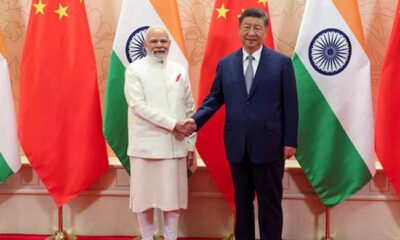Business
Tech frontier: India’s deeptech market set to touch $30 bn by 2030; defence innovation, robotics to drive growth – The Times of India

India’s deeptech sector is on course to become a $30 billion market by 2030, powered by growing defence innovation and a surge in global robotics adoption, according to a report by Redseer Strategy Consultants.The report said India’s deeptech opportunity has expanded 2.5 times over the past five years, with its market base currently estimated at $9–12 billion in FY2025, largely driven by the rapid rise of defence deeptech and robotic technologies, PTI reported.
“India’s deeptech opportunity has grown 2.5 times in the past 5 years and is poised to be a $30 billion juggernaut by 2030. India is emerging as the only trusted, low-cost scale hub outside China,” the report noted.The report highlighted that India’s national defence budget has doubled to $80 billion over the past decade, outpacing growth rates recorded by major global spenders such as the US and China during the same period.This accelerated defence spending has helped fuel domestic innovation in areas like AI-driven autonomous systems, energy propulsion, and advanced drone technology, establishing a strong foundation for sustained deeptech expansion.“Deeptech is no longer tomorrow’s bet — it’s the next economic engine. India’s defence-deeptech flywheel is turning and creating investible, predictable returns,” the report stated.India’s role as a trusted, cost-efficient innovation hub outside China is being reinforced by deeptech-led advances in robotics manufacturing, Redseer said.The global robotics market, valued at $60 billion, is projected to touch $230 billion by 2030, with humanoid robots emerging as a breakout category worth nearly $10 billion.India holds a key cost advantage in this domain – humanoid production costs are about 73% lower than in the US, thanks to local integration efficiency, lower labour costs, and optimised sourcing.
Business
Airlines cancel more than 1,200 flights ahead of winter storm. Here’s what to know

A traveler near a departures board at Newark Liberty International Airport (EWR) in Newark, New Jersey, US, on Monday, Nov. 24, 2025.
Victor J. Blue | Bloomberg | Getty Images
Airlines canceled more than 1,200 U.S. flights on Friday ahead of a major winter storm that will put carriers to the test during one of the busiest travel periods of the year.
A winter storm warning is in effect starting Friday afternoon in New York City, New Jersey and Long Island, with snowfall totals potentially reaching 9 inches, most of it falling overnight, the National Weather Service said.
Over 350 flights, or more than a quarter of the day’s schedule, were canceled as of 1 p.m. Friday to and from New York’s John F. Kennedy International Airport, according to flight-tracking site FlightAware. More than 200 were also scrubbed at Newark Liberty International Airport in New Jersey, and more than 100 were canceled at Philadelphia International Airport.
American Airlines, Delta Air Lines, United Airlines, Southwest Airlines, JetBlue Airways and other carriers waived change fees for restrictive basic economy tickets and said they won’t charge a difference in fare for any other customers flying in and out of a host of airports in the Northeast U.S.
Customers must travel by the end of the year if they change their flights, the airlines said. Flying as early as possible is likely the best bet with few seats available during the busy Christmas week.
Airlines for America, the industry lobbying group, expects carriers to fly a record 52.6 million people between Dec. 19 and Jan. 5, with this Friday and Sunday among the busiest days.
Airlines generally cancel flights ahead of time for major weather events in the forecast, like blizzards or hurricanes, to avoid planes, connecting travelers and crews from getting stranded and worsening disruptions.
Business
Silver rate today: White metal surges to record Rs 2.36 lakh/kg in Delhi; global prices top $75 an ounce – The Times of India

Silver prices climbed to fresh lifetime highs in both domestic and international markets on Friday, driven by strong global cues and thin year-end trading, according to the All India Sarafa Association.In the national capital, silver soared by Rs 9,350 to close at a record Rs 2,36,350 per kilogram on Friday, up from Rs 2,27,000 per kg in the previous session, PTI reported. Over the past four trading sessions, the metal has gained Rs 32,250, or 15.8%, from Rs 2,04,100 per kg on December 19.For the calendar year, silver has recorded an even sharper rise, adding Rs 1,46,650, or 163.5%, from Rs 89,700 per kg on December 31, 2024.Meanwhile, gold maintained its upward momentum in the local bullion market. The precious metal of 99.9% purity jumped Rs 1,500 to touch a new lifetime high of Rs 1,42,300 per 10 grams (inclusive of all taxes), compared with Rs 1,40,800 per 10 grams in the previous session. On a year-to-date basis, gold has gained Rs 63,350, or 80.24%, from Rs 78,950 per 10 grams at the end of 2024.“The precious metals rally continued on the last trading day of the week, with gold and silver reaching new record highs once again,” Saumil Gandhi, Senior Analyst – Commodities at HDFC Securities, said, PTI quoted..In overseas markets, benchmark spot gold rose $50.87, or 1.13%, to hit a fresh lifetime high of $4,530.42 per ounce.“Gold continues to trade at a record high of $4,530 per ounce, buoyed by Fed rate cut expectations and a positive undertone in the commodities market. Thin trading conditions due to the year-end holidays are exaggerating the moves,” Praveen Singh, Head of Commodities and Currencies at Mirae Asset ShareKhan, said.Silver also extended its rally abroad. Spot silver climbed $3.72, or 5.18%, to touch a new high of $75.63 per ounce, breaking past the $75 per ounce mark for the first time.“Spot silver hit a high of $75 during Asian trading hours on Friday. The strong bullish momentum has attracted more momentum-driven traders, who have been active in the precious metals market since early December,” Gandhi added, noting that low liquidity around the Christmas and year-end holiday season has intensified price moves.Structural factors are also supporting silver’s advance, analysts said. Jigar Trivedi, Senior Research Analyst at Reliance Securities, pointed to a multi-year supply deficit, with global mine output lagging demand and above-ground inventories declining.“Structural tightness in the physical market could support much higher prices if deficits deepen,” Trivedi said, highlighting silver’s crucial role in sectors such as solar panels, electric vehicles, 5G and AI electronics, and other clean-tech infrastructure.He also noted that a weak US dollar and rising safe-haven demand could push silver prices toward $100 per ounce in 2026.
Business
Insolvency ruling: CoC cannot alter approved resolution plan or reallocate dissenting creditors’ funds, says NCLAT – The Times of India

The insolvency appellate tribunal NCLAT has ruled that the Committee of Creditors (CoC) cannot modify an approved resolution plan to reallocate funds meant for dissenting financial creditors, reaffirming limits on the exercise of commercial wisdom after a plan has been cleared, PTI reported.Dismissing an appeal filed by Bank of Baroda in the insolvency proceedings of Reliance Communications Infrastructure Ltd (RCIL), a two-member bench of the National Company Law Appellate Tribunal said that once a resolution plan is approved, the assenting members of the CoC cannot alter its financial distribution framework.“It is true that the CoC with commercial wisdom can take a decision regarding different aspects of the plan, including manner of distribution, but once the commercial wisdom has been exercised by approving the resolution plan in meeting, the modification of the said distribution mechanism, which is impermissible, cannot be saved in the name of commercial wisdom of the CoC,” NCLAT said in its order.The appeal arose from the insolvency resolution of RCIL, where the National Company Law Tribunal (NCLT) had approved the resolution plan submitted by Reliance Projects & Property Management Services Ltd (RPPMSL), a subsidiary of Jio. The plan was approved by 67.97 per cent of the CoC by vote share on August 5, 2021.While Bank of Baroda voted in favour of the plan, lenders including IDBI Bank and State Bank of India dissented. The plan was subsequently placed before the Mumbai bench of the NCLT for approval.Bank of Baroda later approached the NCLT seeking directions to convene a CoC meeting to consider reallocation of proceeds under the approved resolution plan, particularly in relation to a loan to Reliance Bhutan. Acting on this, the NCLT on October 17, 2023 directed the resolution professional to convene a CoC meeting.At the meeting held on October 27, 2023, a resolution proposing reallocation and reassignment of the Reliance Bhutan loan was passed with a 67.55 per cent majority, though IDBI Bank and SBI objected to the move.On December 19, the NCLT approved the resolution plan as originally proposed by RPPMSL. IDBI Bank subsequently challenged the October 27, 2023 CoC decision, arguing that the reallocation of proceeds violated the approved resolution plan.The NCLT held that the CoC could not alter the financial layout relating to the entitlement of financial creditors once the resolution plan had been approved. It also noted that the Reliance Bhutan loan, which was to be assigned to assenting financial creditors under the plan, could not be reassigned to dissenting lenders through a subsequent CoC decision.In its October 10, 2025 order, the NCLT ruled that the approved resolution plan could not be modified in this manner. Bank of Baroda challenged this decision before the NCLAT.Upholding the NCLT’s view, the appellate tribunal said, “The Adjudicating Authority in the impugned order after considering all relevant clauses has rightly come to the conclusion that the decision of the CoC dated 27.10.2023 is contrary to the approved resolution plan and cannot bind the dissenting financial creditors.”“We are in full agreement with the view taken by the adjudicating authority as noted above. The adjudicating authority did not commit any error in allowing the plea filed by the IDBI Bank. We do not find any good ground to interfere with the decision of the adjudicating authority,” NCLAT added, dismissing the appeal.
-

 Fashion1 week ago
Fashion1 week agoIndonesia’s thrift surge fuels waste and textile industry woes
-

 Business1 week ago
Business1 week agoBP names new boss as current CEO leaves after less than two years
-

 Tech1 week ago
Tech1 week agoT-Mobile Business Internet and Phone Deals
-

 Sports1 week ago
Sports1 week agoPKF summons meeting after Pakistani player represents India in kabaddi tournament
-

 Entertainment1 week ago
Entertainment1 week agoIndia streamlines visa rules in boost for Chinese professionals
-

 Sports1 week ago
Sports1 week agoUWCL grades for all 18 teams: Leuven get A+; Barça an A-, PSG fail
-
Sports6 days ago
Alabama turned Oklahoma’s College Football Playoff dream into a nightmare
-

 Entertainment1 week ago
Entertainment1 week agoRadiation fears rise after cracks found in $2 billion Chernobyl shield






